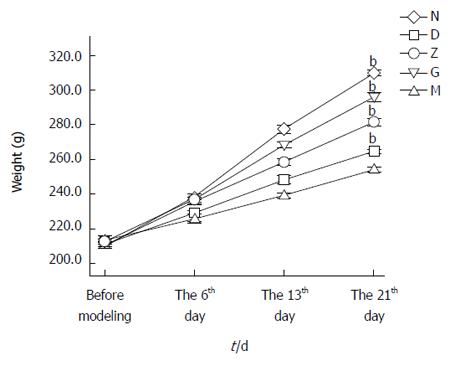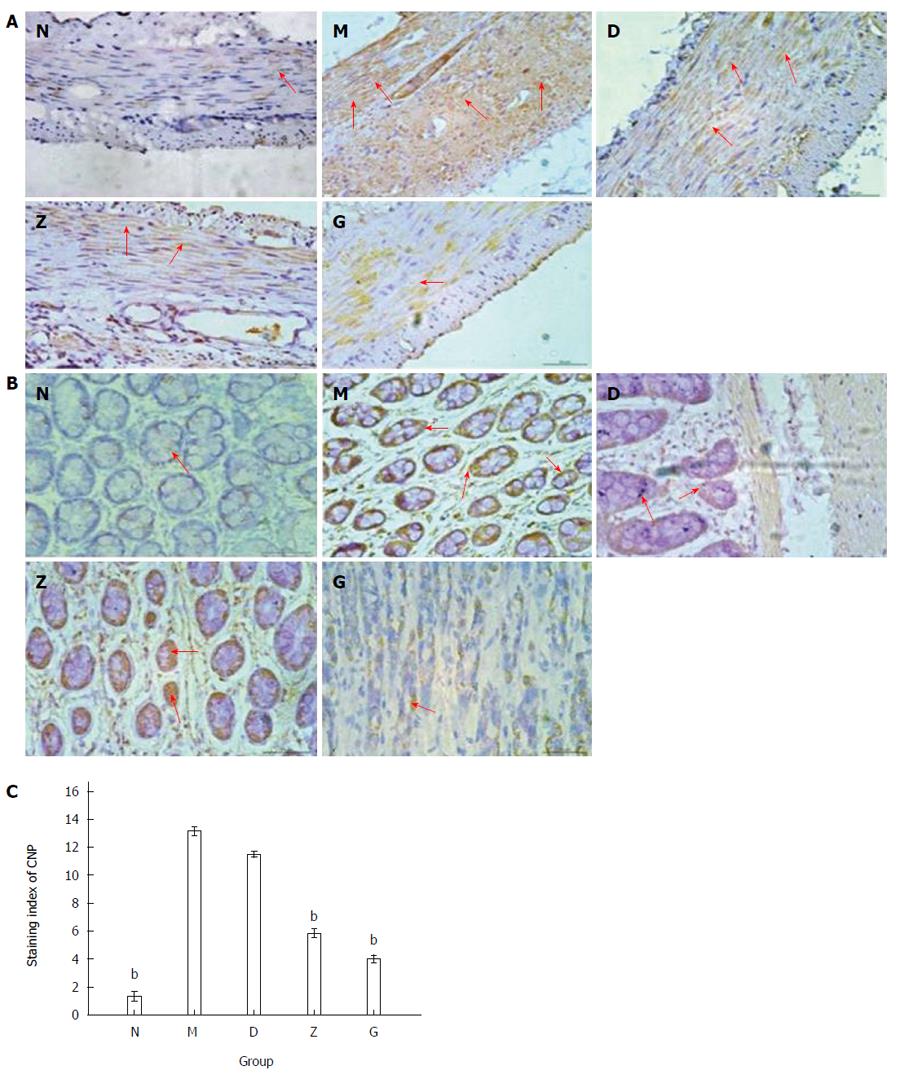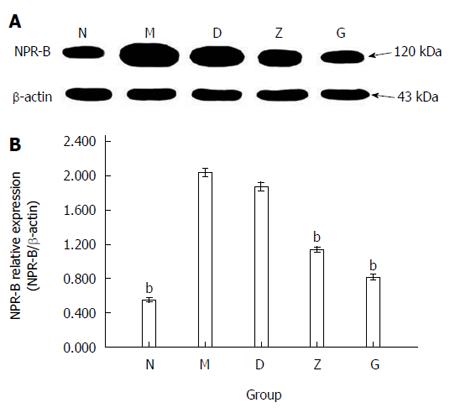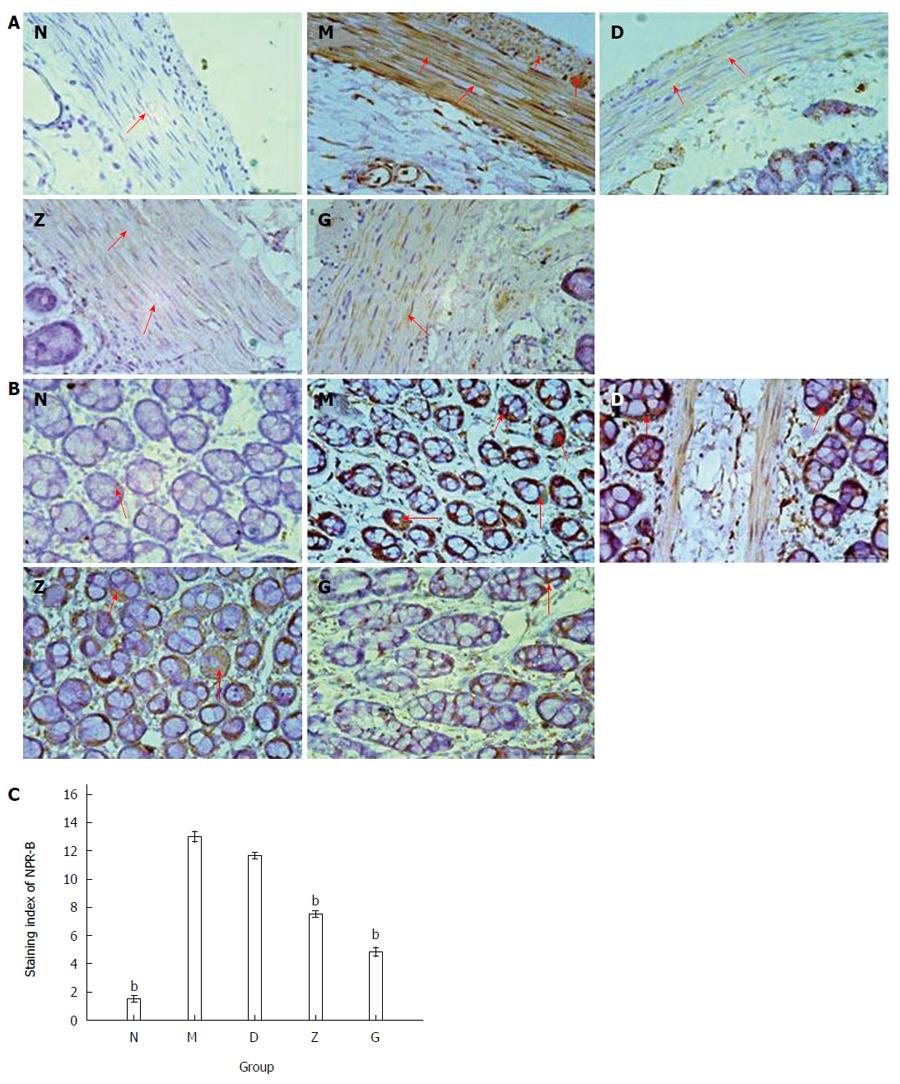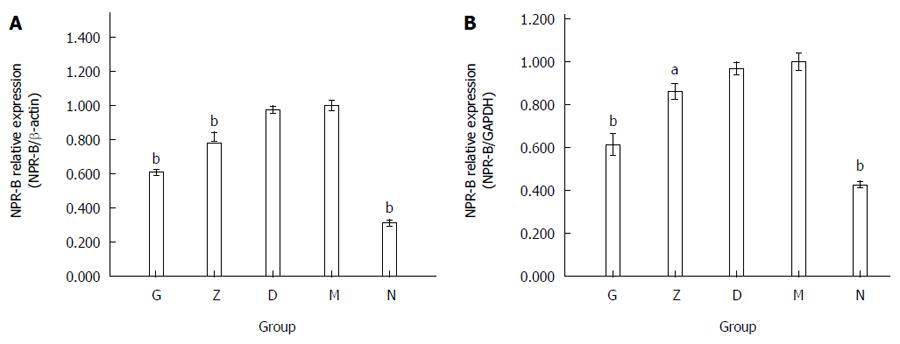Copyright
©The Author(s) 2015.
World J Gastroenterol. Feb 7, 2015; 21(5): 1518-1530
Published online Feb 7, 2015. doi: 10.3748/wjg.v21.i5.1518
Published online Feb 7, 2015. doi: 10.3748/wjg.v21.i5.1518
Figure 1 Weight changes of the five groups of rats.
Data are presented as mean ± SE. N: Primary control group; M: Depression model group; D; Low dose Xiaoyaosan (XYS) group; Z: Middle dose XYS group; G: High dose XYS group. On the 21st day, the difference between the depression model group and the primary control group was significant (n = 9; bP < 0.01 vs M). The difference between the XYS groups and the depression model group was significant (n = 9; bP < 0.01 vs M).
Figure 2 Open-field test of the five groups of rats.
A: Number of grids crossed: (instances that three or more paws crossed into adjacent grids); B: Standing number (number of times two forelimbs were lifted up from the bottom of box to make the body upright); C: Grooming times (number of times two forelimbs were used for grooming, scratching, or licking face and paws). Data are presented as mean ± SE. N: Primary control group; M: Depression model group; D: Low dose Xiaoyaosan (XYS) group; Z: Middle dose XYS group; G: High dose XYS group. On the 21st day, the difference between the depression model group and the primary control group was significant (n = 9; bP < 0.01 vs M). The difference between the XYS groups and the depression model group was significant (n = 9; bP < 0.01 vs M).
Figure 3 Immunohistochemical analysis of C-type natriuretic peptide in rat rectum.
A: C-type natriuretic peptide (CNP) expression in rectum smooth muscle layer of rats (arrows); B: CNP expression in rectum mucosal/serosal layers of rats (arrows); C: Staining index of CNP expression in the rectum of the five groups. Data are presented as mean ± SE. Arrows denote areas of positivity. N: Primary control group M: Depression model group; D: Low dose Xiaoyaosan (XYS) group; Z: Middle dose XYS group; G: High dose XYS group. The difference between the depression model group and the primary control group was significant (n = 9; bP < 0.01 vs M). The high and middle XYS dose groups were significantly different compared with the depression model group (n = 9; bP < 0.01 vs M). Scale bar = 50 μm.
Figure 4 Real-time polymerase chain reaction analysis of C-type natriuretic peptide in rat rectum.
A: C-type natriuretic peptide (CNP) mRNA transcript levels were normalized to β-actin. B: CNP mRNA transcript levels were normalized to GAPDH. Values of ΔΔCt are expressed as ratios of model group expression level. β-actin and GAPDH are used as the internal control. Bars represent data presented as mean ± SE. N: Primary control group; M: Depression model group; D: Low dose Xiaoyaosan (XYS) group; Z: Middle dose XYS group; G: High dose XYS group. The difference between the depression model group and the primary control group was significant (n = 9; bP < 0.01 vs M). The high and middle XYS dose groups were significantly different compared with the depression model group (n = 9; bP < 0.01 vs M).
Figure 5 Western blotting analysis of natriuretic peptide receptor B expression in rat rectum.
A: Natriuretic peptide receptor B (NPR-B) and β-actin protein expression levels in rat rectum tissue. Assayed NPR-B protein or β-actin by immunoblot analysis. β-actin was used as a loading control. Lane N: Primary control group; Lane M: Depression model group; Lane D: Low Xiaoyaosan (XYS) dose group; Lane Z: Middle XYS dose group; Lane G: High XYS dose group. Protein bands have been altered via image processing software (Adobe Photoshop CS3) to get a cleaner background; B: Panel shows the expression of NPR-B and β-actin protein levels by relative optical density measurement in rat rectum. Data are presented as mean ± SE. The difference between the depression model group and the primary control group was significant (n = 9; bP < 0.01 vs M). The high and middle XYS dose groups were significantly different compared with the depression model group (n = 9; bP < 0.01 vs M). CNP: C-type natriuretic peptide.
Figure 6 Immunohistochemical analysis of natriuretic peptide receptor B in rat rectum.
A: Natriuretic peptide receptor B (NPR-B) expression in rectum smooth muscle layer of rats; B: NPR-B expression in rectum mucosal/serosal layers of rats; C: Staining index of NPR-B expression in rat rectum of the five groups. Data are presented as mean ± SE. Arrows denote areas of positivity. N: Primary control group; M: Depression model group; D; Low dose Xiaoyaosan (XYS) group; Z: Middle dose XYS group; G: High dose XYS group. The difference between the depression model group and the primary control group was significant (n = 9; bP < 0.01 vs M). The high and middle XYS dose groups were significantly different compared with the depression model group (n = 9; bP < 0.01 vs M). Scale bar = 50 μm.
Figure 7 Real-time polymerase chain reaction analysis of natriuretic peptide receptor B in rat rectum.
A: Natriuretic peptide receptor B (NPR-B) mRNA transcript levels were normalized to β-actin; B: NPR-B mRNA transcript levels were normalized to GAPDH. Values of ΔΔCt are expressed as ratios of model group expression level. β-actin and GAPDH are used as the internal control. Bars represent data presented as mean ± SE. N: Primary control group; M: Depression model group; D: Low dose Xiaoyaosan (XYS) group; Z: Middle dose XYS group; G: High dose XYS group. The difference between the depression model group and the primary control group was significant (n = 9; bP < 0.01 vs M). The high and middle XYS dose groups were significantly different compared with the depression model group (n = 9; bP < 0.01 vs M).
- Citation: Li P, Tang XD, Cai ZX, Qiu JJ, Lin XL, Zhu T, Owusu L, Guo HS. CNP signal pathway up-regulated in rectum of depressed rats and the interventional effect of Xiaoyaosan. World J Gastroenterol 2015; 21(5): 1518-1530
- URL: https://www.wjgnet.com/1007-9327/full/v21/i5/1518.htm
- DOI: https://dx.doi.org/10.3748/wjg.v21.i5.1518









